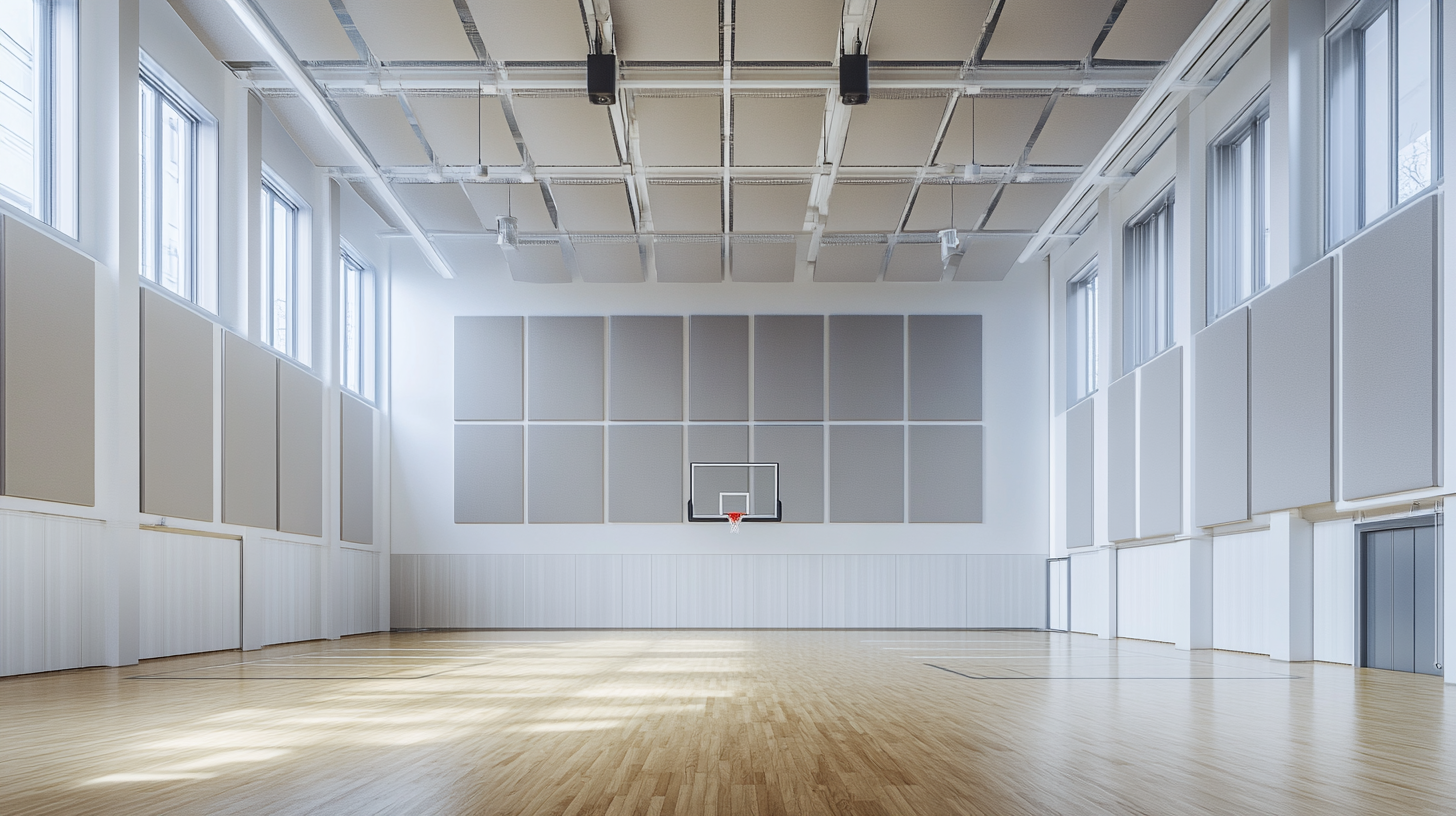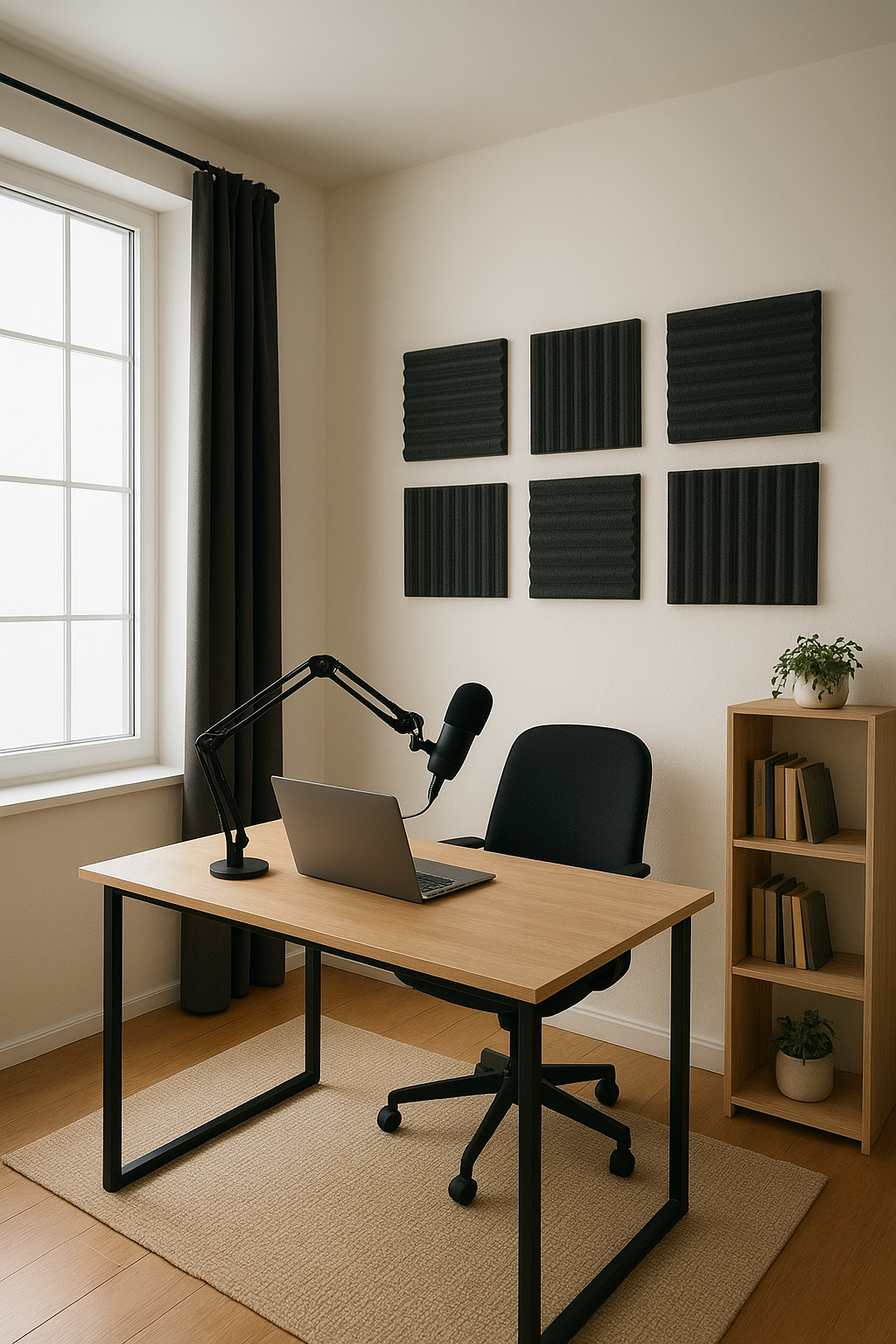Comprehensive Guide to Soundproofing a Gymnasium
Gymnasiums are some of the most acoustically challenging spaces to manage. High ceilings, open layouts, and hard reflective surfaces create a perfect storm for echo and reverberation. Add multiple simultaneous activities - like sports, fitness classes, and events - and noise quickly gets out of control.
Most gyms are built with concrete, brick, and metal. These materials reflect sound rather than absorb it. So when someone shouts, or a ball hits the floor, the sound bounces endlessly across the space.
Another factor is impact noise. Running, jumping, and bouncing balls create vibrations that travel through walls, floors, and even the air. In gyms with amplified sound systems, the noise level increases dramatically during games and assemblies.
Without proper gym soundproofing, speech clarity can suffer, constant distractions can occur, and even safety risks can occur when emergency announcements can't be heard clearly.
Why Gymnasium Soundproofing Matters
Soundproofing a gymnasium is about making it quieter, usable, and safe.
One key benefit is improved speech intelligibility. Coaches, teachers, and announcers must be heard clearly over ambient noise. In noisy environments, even the best PA systems fall short unless acoustics are under control.
A clearer sound also means better safety. Emergency alerts and instructions must be heard instantly. This is especially important in schools or community centers where multiple events happen simultaneously.
A well-treated gym also becomes a more effective learning environment. Students can focus on instructions without the distraction of lingering echoes or background noise.
In multipurpose buildings, gym noise often bleeds into adjacent classrooms, offices, or residential units. Good soundproofing reduces complaints and improves the experience for everyone in the building.
From a legal and design standpoint, many jurisdictions require compliance with building codes and noise regulations. That makes professional acoustic design not just a bonus - but a necessity.
Finally, better sound control means more flexible use of space. A soundproofed gym can host fitness classes next to a basketball game or serve as a venue for public events without overwhelming noise issues.
Assessing Your Gymnasium's Acoustic Needs
Before making changes, you need to understand what you're dealing with. Every gym is different in size, layout, and surface materials.
Common problems include excessive reverberation, poor speech clarity, and uneven sound distribution. Large flat walls and ceilings allow sound to bounce freely, creating overlapping reflections that reduce intelligibility.
We start by measuring reverberation time (RT60) - the time it takes for sound to decay in the space. High RT60 times are typical in untreated gyms and signal the need for acoustic treatment.
We also assess noise sources. This includes ambient sound from HVAC systems, crowd noise, mechanical equipment, and sporting activity. Identifying trouble spots - such as corners, near bleachers, or under metal roofs - helps prioritize treatment zones.
Next, we examine the building structure. Older gyms often have architectural constraints that limit where treatments can go. Newer spaces might have more flexibility.
Finally, we set realistic goals. Full silence isn't the goal - balanced acoustics are. For most gyms, reducing reverberation time and improving clarity are top priorities.
Wall Treatment Strategies for Gymnasium Soundproofing
Acoustic Wall Panels
One of the most effective ways to control sound in a gym is to use acoustic wall panels. These panels absorb mid- and high-frequency sounds, which reduces echo and improves clarity.
In gym environments, NRC ratings of 0.80 or higher are ideal. NRC (Noise Reduction Coefficient) indicates how much sound a material can absorb. Higher numbers mean better absorption.
Durability is critical. Gym wall panels must be impact-resistant to withstand ball strikes, equipment contact, or accidental bumps. Many products feature reinforced vinyl or woven fabric faces over fiberglass cores.
Placement matters too. Panels are usually installed between 6 to 10 feet above the floor - out of reach of regular contact but close enough to intercept reflected sound. For maximum coverage, aim to treat at least 25-35% of wall surface area.
In sports-focused facilities, consider sport-specific acoustic panels designed to meet athletic safety standards without sacrificing performance.
Diffusers and Bass Traps
In large gyms, sound doesn't just bounce - it builds up in unpredictable ways. That's where diffusers and bass traps come in.
Diffusers scatter sound waves, preventing harsh echoes and standing waves. They're especially useful in multi-court spaces where sound can pile up in corners or under ceilings.
Bass traps absorb lower frequencies that panels may miss, such as footfall, music bass, or subwoofer rumble from events.
Gymnasiums often require custom designs. Large-format diffusers and corner-mounted bass traps are tailored to fit tall wall sections or ceiling transitions. Integration with existing wall finishes ensures performance without compromising aesthetics.
These advanced elements are often installed with standard sound-absorbing panels for gyms for best results.
Ceiling Solutions for Controlling Gymnasium Acoustics
Suspended Acoustic Ceiling Systems
When working with high ceilings, one of the most effective strategies is installing a suspended acoustic ceiling system. These systems use a drop grid to hold large-format sound-absorbing tiles.
In gymnasiums, tiles must be impact-resistant and able to withstand occasional contact from balls or equipment. Look for tiles with a high NRC rating and reinforced surfaces. Some are designed specifically for ball impact zones, using durable facings or sealed edges.
Installation in large spans requires careful planning. Structural supports must be evaluated, especially if the space hosts sports like basketball or volleyball. In some cases, partial coverage - such as center-court sections or perimeter zones - can still provide a major acoustic improvement.
Direct-Mount Ceiling Panels
Direct-mount acoustic ceiling panels are a strong alternative if your gym has exposed structures or lacks the height for a drop ceiling.
These panels are fixed directly to beams or the underside of the roof deck. They can follow the architecture of the space while significantly reducing reverberation time.
To notice a significant difference, you'll typically need 50-70% ceiling coverage. Choose panels made for gym environments, with sealed edges and moisture resistance.
Direct-mount panels also work well in retrofits or multipurpose spaces with limited design flexibility. They're discreet but effective - especially when paired with acoustic panels for gymnasium walls.
Floor Treatments That Reduce Impact Noise
While most attention goes to walls and ceilings, the floor is a major source of impact noise in gyms. Footsteps, weights dropping, and sports movements create vibrations that travel through the structure.
The solution? Specialized flooring systems with acoustic underlayment. These combine shock-absorbing surfaces with layers that isolate vibrations before they spread.
In weight rooms, rubber tiles with sound-dampening sublayers can prevent structural noise from reaching nearby classrooms or offices. In aerobic or dance studios, cushioned floating floors improve performance and acoustics.
For extreme cases - such as gyms in mixed-use buildings - floating floor assemblies with full isolation may be needed. These systems sit on resilient mounts that decouple the entire floor from the substructure.
Performance varies by sport, so the material choice must match the intended use. A basketball court needs different specs than a powerlifting zone.
Addressing Mechanical and HVAC Noise
Mechanical noise is one of the most overlooked issues in gymnasiums. HVAC systems, exhaust fans, and lighting ballasts all contribute to the overall noise level, which often echoes in open spaces.
Start by isolating HVAC units using vibration dampers and soundproof enclosures. Ductwork should include silencers or lined diffusers to reduce whooshing and fan noise.
Mechanical equipment rooms adjacent to gyms need treatment, too. Adding dense wall panels, door seals, and ceiling absorption can help contain machine noise.
Also, check scoreboards, PA systems, and lighting fixtures. Many produce electrical hum or buzzing. These should be mounted using anti-vibration brackets or housed in treated enclosures.
Even equipment like retractable bleachers and electric basketball hoops can cause sound reflections. Padding and wall treatments near these installations help absorb their acoustic footprint.
Best Materials for Gymnasium Soundproofing
High-Performance Acoustic Panels
When choosing materials, go for fiberglass core panels wrapped in vinyl or tough fabric. These panels offer excellent NRC ratings and long-term durability.
You can also choose fabric-wrapped panels for design flexibility, which are available in colors that match your school or branding. They're ideal for areas where aesthetics matter as much as performance.
Want a green solution? Many manufacturers now offer recycled-content panels made from sustainable materials, with low-VOC adhesives and coverings.
Specialized Gymnasium Products
Some materials are designed specifically for gyms, combining safety and sound control.
For example, sound-absorbing wall padding protects athletes while reducing echo. These dual-purpose panels are common under basketball hoops and along sidelines.
Acoustic divider curtains are another smart solution. They separate the space for multiple activities while helping reduce cross-court noise. Some come with integrated sound-absorbing cores.
Look for sport-certified materials that meet ASTM or NFPA safety requirements while still offering real acoustic performance.
Durable Yet Effective Materials
In high-abuse environments, you may need more rugged options. Perforated wood or metal panels backed with acoustic insulation provide durability without sacrificing absorption.
Composite materials are also growing in popularity. These combine a hard, impact-resistant face with a soft sound-absorbing core - ideal for high-traffic zones.
In poolside gyms or locker rooms, look for moisture-resistant materials. PVC-faced panels, treated fiberglass, and mold-resistant fabrics maintain performance in humid or wet conditions.
Installation Approaches and Considerations
Installing gym soundproofing comes with unique challenges. You often have to work around hoops, scoreboards, lighting grids, and fixed seating.
One approach is phased installation. Treatments can be installed in sections during off-hours, avoiding full facility shutdowns. This is ideal for schools and year-round gyms.
Height access is another issue. Certified installers may need lifts or scaffolding to reach high walls and ceilings. Planning for safety and logistics is critical.
While some products offer DIY installation, most gymnasium projects benefit from professional acoustic consultants. Expert teams ensure safe installation, compliance with fire codes, and optimal coverage.
Budget-Friendly Strategies for Maximum Impact
Not every gym needs a full-scale acoustic overhaul. Smart prioritization can deliver great results on a budget.
Focus first on problem zones - like walls behind basketball hoops or reflective ceiling sections over courts. Treating just 25-30% of key surfaces can noticeably reduce echo.
You can also combine aesthetic renovations with acoustic upgrades. For example, new wall graphics or padding can be made from sound-absorbing materials.
Use value-engineered materials that balance performance with cost. Some budget panels offer good NRC ratings at a lower price point than premium architectural lines.
Over time, better sound control also pays off. You get fewer complaints, more bookings, and improved user satisfaction. For schools, better acoustics may even support improved performance in PE and group activities.
Maintaining Your Acoustic Treatments
Acoustic treatments are low-maintenance - but not no-maintenance. Different materials have different care needs.
Fabric panels should be vacuumed or dusted regularly. Spot cleaning is usually fine, but avoid strong chemicals. Vinyl-covered panels can be wiped clean with damp cloths or mild cleaners.
For damaged panels, many manufacturers offer replacement covers or core refills. Impact-resistant products hold up better but may still need occasional touch-up.
Expect most treatments to last 10-15 years with minimal performance loss. In high-abuse areas, schedule annual inspections to check for wear.
Eventually, styles or needs may change. Upgrading materials or refreshing color schemes can be done without redoing the entire system.
Need help in soundproofing a gymnasium? At New York Soundproofing, we design and install custom gym soundproofing systems that control noise, enhance safety, and improve the acoustic experience for every user.
.png)


.png)